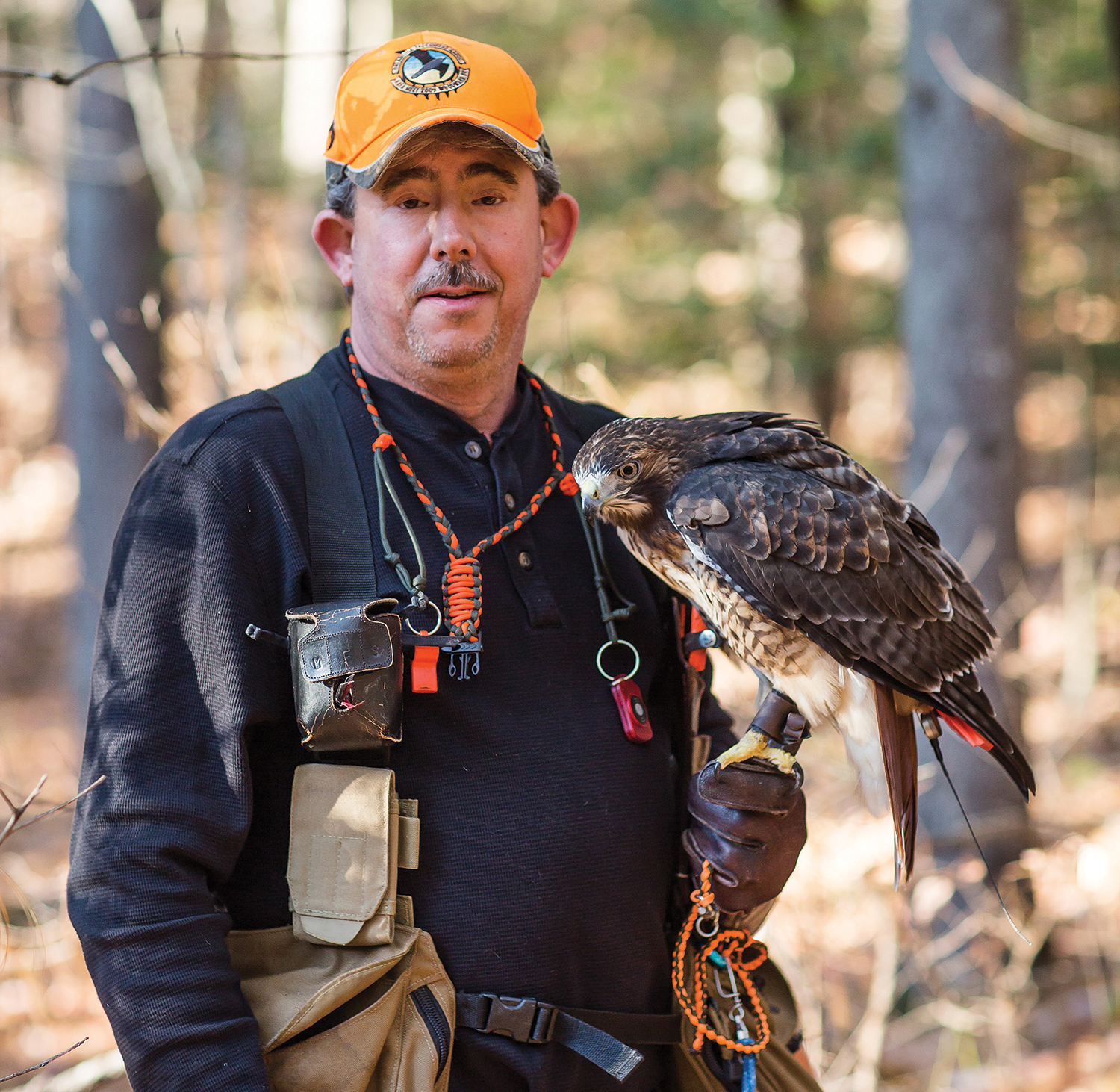
“It’s a participatory sport,” says Brent Besosa. Falconers typically develop close relationships with their birds. Photo by Tim Robison
Perched on a tiny oak limb, more than 50 feet in the air, is a red-tailed hawk named after its proud coloring: Eric the Red. He’s quiet. His eyes roam the woods in Bent Creek. He looks for movement. He’s perfectly still for a few moments, oblivious to his owner on the ground.
That’s where Brent Besosa, along with his son, Trevor, bang on trees, rustle the undergrowth, and talk back and forth as they try to uncover small animals. Their noise doesn’t faze Red, who, after less than 20 minutes, spots a gray squirrel, swoops down, and catches the animal with its razor-sharp talons.
Besosa is a Mills River-based realtor whose long-time favorite sport is reflected on his business card: He’s a member of the Falconry Realty Team with Coldwell Banker in Hendersonville. The hunter or his son are out daily with Red during the fall and winter, and they spend a lot of time wandering through the woods. Typically Besosa walks the trails and Red follows. Sometimes the hawk is 50 or 60 yards behind Besosa, with his trained eyes looking for prey. When Besosa claps, the bird often flies to a branch closer to his helper.
Then there’s the moment when it happens — when Red, who Besosa captured near his home to be a trained bird, goes into action.
“It’s a cat-and-mouse game once the chase is on. It can last two seconds or it can last 20 minutes,” says the falconer. “We’re sort of a participant down here. We’re distracting the squirrel, trying to cut off the holes in the trees. It’s a participatory sport.”
Falconry dates back thousands of years, to when kings kept legions of falconers to help feed the family. The sport has enjoyed plenty of pop-culture references, too. It’s a central motif in the Arthurian fantasy novel The Once and Future King, appears in symbolics scenes in Wes Anderson’s offbeat, dysfunctional-family film The Royal Tenenbaums, and figures in a skit on Saturday Night Live where Will Forte, playing “The Falconer,” needs his hawk, Donald, to frequently rescue him.
The ancient practice has become newly trendy the last few years. In Western North Carolina, beginners’ workshops for would-be falconers are hosted in meadows and woods from Weaverville to the Cradle of Forestry.
But that’s the showy side of the sport. Most people don’t understand the time involved. Serious falconers don’t rest their birds, they work them. If they don’t hunt, they’re just keeping a bird as a pet, and that just isn’t Besosa, who sports a few scars from where a hawk’s nicked him with a claw. He has access to several pieces of private property where he and his birds help control the population of small animals. Hawks like Red are opportunistic eaters, so snakes, mice, insects, crawfish, and other small creatures are seen as snacks.

In the woods, falconers put masks on their hawks so they don’t spot edible critters until the moment they’re released. Photo by Tim Robison
He’s used several hawks, and other birds of prey, over the years. “Falconers want birds who are indigenous to their area because you want to hunt the prey base that you have,” he explains. “When we return them to the wild, after one to three years, they’ve had none of the stresses of living in the wild because we take care of them like babies. But they’ve had all of the experiences of hunting intensified. When we turn a bird loose, they’ve had several years of hunting experience in one or two years.”
Besosa grew up in the southern tier of New York State, where he befriended Dr. Heinz Meng, a professor of biology at SUNY New Paltz. Meng, who passed away in August, was considered one of the most influential falconers in the United States, credited with the recovery of the once-endangered peregrine falcon in the eastern U.S. Besosa would help rouse prey with Meng as a teenager, but didn’t get enamored with the sport until years later.
Trevor, then a teen himself, came home after a field trip where a falconer spoke about the sport, and said he wanted to try it. That was all it took for the father and son to add another layer to their bond.
They went through the process of becoming falconers, which includes an apprenticeship, and now are often seen working Red together.
It isn’t uncommon for Besosa to carry his birds to speak to Boy and Girl Scout troops, non-profit organizations, or school groups, where he talks about conservation and the sport of falconry.
“We don’t always kill something,” he explains. “It’s about the chase, getting the bird out. It’s about understanding this animal so closely that we can have a relationship.
Brent Besosa is always on the lookout for wooded property to hunt on and groups to speak with. Reach him at 828-277-8194. For more information about falconry programs in North Carolina, visit the page of the NC Falconry Guild at www.ncfg.org.
